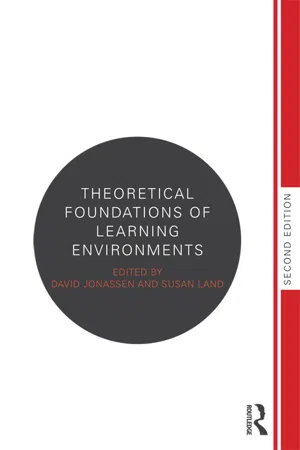The Role of Epistemology in Learning Environments
Epistemological shifts have engendered a variety of innovative and provocative learning environments. Interest in student-centered teaching and learning, for example, has given rise to myriad approaches to provide flexible and powerful alternatives to the design of instruction (Jonassen, 1991). Student-centered environments, tacitly or explicitly, are designed to support individual efforts to negotiate meaning while engaging in authentic activities. Student-centered approaches reflecting epistemological variants have emerged including problem-based learning (Hmelo-Silver, 2004), anchored instruction (Cognition and Technology Group at Vanderbilt, 1992), cognitive apprenticeships (Collins, 2006), computer-supported collaborative learning (Stahl et al., 2006), learning-by-design (Kolodner, 2006), project-based learning (Krajcik & Blumenfeld, 2006), games and simulations (D. Clark et al., 2009), and open learning environments (Hannafin, Land, & Oliver, 1999). While operationalized differently, student-centered learning environments share common epistemological foundations and assumptions. SCLEs are grounded in a constructivist view of learning, where meaning is personally rather than universally defined. Such perspectives draw heavily from psychological research and theory related to areas such as situated cognition (Brown, Collins, & Duguid, 1989) with attendant assumptions emphasizing the interlacing of content, context and understanding, the individual negotiation of meaning, and the construction of knowledge (Jonassen, 1991). Pedagogically, SCLEs favor rich, authentic learning contexts over isolated, decontextualized knowledge and skill, student-centered, goal-directed inquiry over externally directed instruction, and supporting personal perspectives over canonical perspectives. Technology tools support the individual's identification and manipulation of resources and ideas (Iiyoshi, Hannafin, & Wang, 2005).
With increased popularity, however, fundamental questions have arisen related to the kinds of learning such environments support, how best to design them, and whether or not designs can be generalized across varied domains and contexts (Dick, 1991; Merrill, 1991; Kirschner et al., 2006). Numerous “how to” guidelines have been offered, but they typically lack adequate theoretical or empirical framing (Hannafin & Land, 1997). Given the unique student-centered learning goals and requirements, it may be impossible to derive an inclusive design model. Rather, we need to identify frameworks for analyzing, designing, and implementing learning environments that embody and align particular foundations, assumptions, and practices.
Clark (Clark & Hannafin, 2011) recently described “pitfalls” and shortcomings of constructivist-inspired learning environments such as discovery learning research and practice, citing examples to support his assertion that fully-guided, direct instruction results in superior performance in virtually all cases. Similar arguments have been presented for constructivist-inspired learning strategies and environments including student-centered learning, inquiry-based learning, and self-directed learning (Kirschner et al., 2006). Clark also suggested that empirical evidence generated from directed-learning studies is applicable to all types of learning independent of the associated epistemological roots. He suggests personal perspectives might unduly sustain the popularity of minimally-guided approaches in the absence of empirical evidence. Finally, Clark cautions “Far too many in our field are avoiding inconvenient evidence in favor of self-serving beliefs and opinions” (p. 375). He questions the preparation and motivation of non-adherents: “few people have the motivation or training necessary to invest the effort required to carefully review complex research on learning and instruction … ambivalence about research training in our instructional technology and instructional systems graduate programs is certainly a contributing factor” (p. 375). He concludes that programs that do not heed his advice “risk causing harm to people who depend on us” (p. 375).
But are the goals, assumptions, and learning contexts of these approaches really comparable to those based on learning from direct instruction? Clark et al.'s guidance is only occasionally viable when the circumstances and assumptions guiding design decisions are aligned. His perspectives, methods, and findings do not align with widely adopted approaches advanced by reputable theorists, researchers, and practitioners with different perspectives. Hmelo-Silver, Duncan, and Chinn (2007) challenged Kirschner et al.'s (2006) use of the term minimal guidance: “problem-based learning (PBL) and inquiry learning (IL), are not minimally guided instructional approaches but rather provide extensive scaffolding and guidance to facilitate student learning” (p. 99). McCaslin and Good (1992) noted, “the intended modern school curriculum, which is designed to produce self-motivated, active learners, is seriously undermined by classroom management policies that encourage, if not demand, simple obedience” (p. 4). The authors suggest that both teachers and students require sustained opportunities and support in order to adapt and implement significant pedagogical changes. Optimal guidance is needed where learning outcomes are not or cannot be explicitly predefined.
We do not argue for inherent superiority (or inferiority) of one perspective or approach over alternatives. We do not intend to fuel what is often a rancorous ongoing debate, but to advance a more principled approach to linking teaching, learning, and technology. Since learning is the goal of design, we need to clarify the type(s) of learning we mean to facilitate. Learning systems design has evolved frameworks that provide important and useful ways to support directed learning. So, while we acknowledge that fully-guided direct instruction is often well-suited to support external learning requirements, these same methods and models cannot adequately support learning that has become increasingly spontaneous and self-directed within and across formal (e.g., independent follow-up on debates related to global warming or Jefferson's ancestry) and informal settings (e.g., learning the causes of home garden infestations or the impact of recent tax laws on personal finances). We acknowledge that different learning goals exist, recognize the implications of these perspectives on design and learning, and identify strategies that are best aligned with and appropriate for a given learning need.
